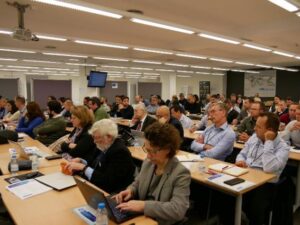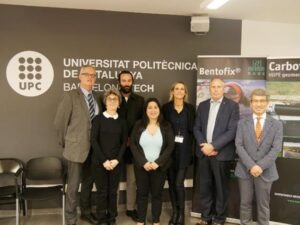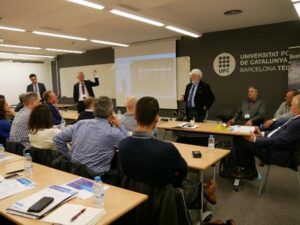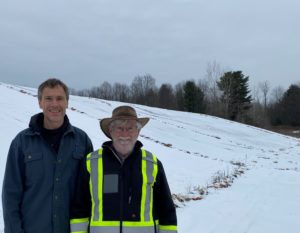The IGS Technical Committee on Barrier Systems (TC-B) has been dedicated to championing the greater use and understanding of geosynthetic barrier materials for more than a decade.
As it enters its 13th year of formation this month, we talk to TC-B chairman Jonathan Shamrock on its development and direction as we continue our series exploring the IGS’s Technical Committees.
More than a decade in action
Founded in May 2010 during the 9th International Conference on Geosynthetics (ICG) in Guarujá, Brazil, the TC-B was formed to promote the knowledge, technology, research, design, and construction methodologies related to geosynthetic barrier applications and related technologies. These applications could include guarding against seepage loss, improving fluid flow, or isolating contaminated soils in geo-environmental engineering.
The committee was first chaired by Abdelmalek Bouazza, with Kent von Maubeuge and Boyd Ramsay as vice-chairs, and Natalie Touze as secretary. Jonathan Shamrock, based in New Zealand as a civil engineering consultant for Tonkin & Taylor Ltd, is current chairman after being appointed in September 2020 for a four-year term.
His vice-chair is Jabulile Msiza who works as a civil engineering consultant with Jones & Wagener Ltd in South Africa, and is also chair of the IGS’s Africa-Middle East Regional Activities Committee. Amir Shahkolahi, a technical manager for Australia and New Zealand at Global Synthetics, based in Australia, is secretary.
Mr Shamrock said: “We are also privileged to have immediate past chair Kent von Maubeuge, who is a director and senior product manager at NAUE, and previous vice-chair Boyd Ramsay, who is an independent consultant. They provide continuity within the committee and are also both on the Board of Trustees of the IGS Foundation, which is a great link to have for the TC-B.
“Having this wealth of insight and experience has been invaluable in maintaining a dynamic resource for IGS members.”
Boosting education
The driver for the TC-B is simple: continually striving to improve knowledge worldwide about the correct use and application of geosynthetic barrier systems.
Mr Shamrock explained: “There are new people entering the market every year and unfortunately the topic of geosynthetics is not covered much in a typical civil engineering degree or diploma. For people already working in the industry there is a constant flow of new materials, new products and new research that impacts the way they are used.
“Unfortunately, there is always a lot to learn in terms of understanding the plethora of geosynthetic materials available in the market, and what to consider at the specific site level when you use them. Good products used incorrectly will fail, and unfortunately, it’s the product that is often blamed, rather than it being used in the wrong application or with an incorrect design or installation. Therefore, ensuring accurate, up-to-date and comprehensive information easily accessible worldwide is key for the TC-B.”
Mr Shamrock said the TC-B was also keen to collaborate with chapters in supporting their related events. The committee assisted the Australasian Chapter of the IGS, (known as ACigs), with organising a forum session on geomembrane durability and the role of antioxidant packages in March 2021. The TC-B also delivered a webinar for the Philippine Chapter of the IGS last month on ‘Environmental applications of geosynthetics in landfills’.
“It’s a great way for local issues to be addressed with input from the IGS worldwide network of experts,” he said.
Further events of note included a workshop session in Barcelona in January 2020 on “GeoBarrier developments, advancements, durability, performance, and innovations” attended by 84 delegates from 23 countries. The workshop was divided into four sessions over two days, each beginning with four or five presentations followed by questions and a discussion, enabling participants to share project experience, exchange technical concerns and solutions, and network with colleagues.



Also, earlier this year, the TC-B together with the newly-created IGS Recognitions Task Force, established the Kerry Rowe Lecture in recognition of Dr. Rowe’s long service to the IGS and outstanding contribution to geosynthetics. The new lecture will be delivered during the TC-B session of every ICG, beginning with the 12th ICG in Rome in September 2023, further ensuring barrier systems are given a worldwide stage.

Broadening accessibility
But it’s not just about education for the TC-B. Ensuring information from manufacturers and academics get to practitioners, clients and project owners when they want and in the way they want to receive it is also a significant focus.
Mr Shamrock said: “The more the products are understood the better they will be used, and the better the outcomes will be for the projects. Geosynthetics have a proven track history to improve project programme, cost, resilience and sustainability, if used appropriately – and it’s key to ensure all this information is available to the right audience at the right time.”
The TC-B’s successful webinar series of eight sessions on specific technical issues of barrier manufacturing, installation and performance, rolled out over 2021 is a case in point. Average registrations per webinar doubled by the end of the series – from 200 to 400 – while the number of countries the registrations came from rose from 30 to 50 by the end of the run.
“To see the enthusiasm and thirst for knowledge that is out there in the geosynthetic community is very rewarding,” said Mr Shamrock. “We need to make sure, even when face-to-face events return in force, that we continue to make content like this available virtually or through hybrid conferences, and via the IGS Digital Library, to boost accessibility worldwide.”
The TC-B is also busy planning:
- An in-person workshop session, possibly a shared event with the Technical Committee on Hydraulics (TC-H).
- A lecture to be added to the University lecture series available on the IGS website, dealing specifically with geosynthetic barriers and how they are used on landfills. An updated leaflet on this issue has also recently been added to the IGS Digital Library.
- Planned TC-B sessions at upcoming IGS conferences, including GeoAsia7 in Taipei, Taiwan, in October 2022, Geosynthetics Conference, in Kansas, USA, in February 2023, GeoAfrica in February 2023 in Cairo, Egypt, and the 12th ICG in Rome, Italy, in September 2023.
- Collaboration with the TC-H for a workshop on geosynthetic applications in hydraulic engineering to be held at the 24th International Commission on Irrigation & Drainage (ICID) Congress in October 2022 in Adelaide, Australia.
The TC-B also welcomed a recent award of funding by the IGS Foundation to research student Vahid Vakili to collect and summarize the worldwide regulations, design recommendations and guidelines for geosynthetic barrier systems. Mr Vakili’s work builds on efforts previously carried out by the TC-B, and will be publicly available for all to access after its expected completion early next year.
Get involved
Participating in the TC-B is easy. Any individual members and representatives from corporate IGS members can join any of the TCs via the IGS website. Members will be added to the TC-B database and receive the latest news, upcoming events, and other opportunities.
Mr Shamrock said the TC-B was also keen to support projects related to the committee’s aims and urged members to get in touch with their ideas.
“I’d encourage members to get involved in the work of the TC-B – not only will you be first to hear about our initiatives but you’ll be linked to a worldwide network of IGS individuals and businesses working in the barrier field.”
He added: “I’m very grateful for the enthusiasm and commitment of the members of the committee, and of the broader IGS and geosynthetics community, to support us with their time and expertise. We are passionate in our mission to champion barrier systems and urge members to engage with us and our work.”
Discover more about the IGS Technical Committees, and how to join, here.
*** Missed our first article on the origins of the IGS Technical Committees? Click here to read more.






















